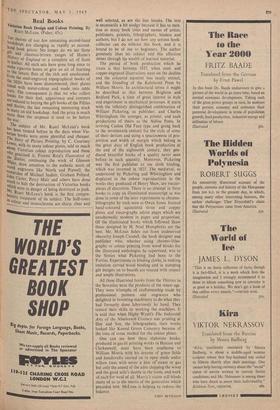Real Books
Victorian Book Design and Colour Printing. By Ruari McLean. (Faber, 45s.)
THE shelves of our few remaining second-hand bookshops
are changing as rapidly as second-
hand book prices. No longer do we see those gilt and chestnut-brown ranges of Hume's yistory of England or a complete set of Scott in leather. All such sets have gone long since to Make cigarette boxes or give an air of learning to the luxury flats of the rich and uneducated. Even the steel-engraved topographical books of the 1820s have been dismembered, their plates tinted with water-colour and made_ into table mats. The consequence is that we who collect books for their feel, appearance and contents are reduced to buying the gift books of the Fifties and Sixties, the last remaining interesting stock 1_11 many an old bookshop. And the price is much
more than the sixpence it used to be before the war.
, The subject of Mr. Ruari McLean's book nas been treated before in the days when Vic- torian books were more plentiful and cheaper. Trhe Story of Picture Printing, by C. Courtney 'ewes, with its many colour plates, told us much about Victorian colour reproduction and those who practised it; Forrest Reid's Illustrators of the--ixti:
White, continuing the work of Gleeson
—.lite, drew attention to the msthetic merit of wood engravers like North and Pinwell; the researches of Michael Sadleir, Graham Pollard, John Carter, Percy Muir and others have done Much to halt the destruction of Victorian books which were in danger of being destroyed as junk. Mr. .Rilari McLean's book is the first compre- hensive treatment of its subject. The half-tones In colour and monochrome are sharp, clear and well selected, as are the line blocks. The text is necessarily a bit stodgy because it has to men- tion so many book titles and names of artists, publishers, printers, lithographers, binders and authors, but I do not see how any serious book- collector can do without this book, and it is bound to be of use to beginners. The author genuinely likes his subject and this affection shines through his wealth of learned material. The period of book production which he treats is that between 1837, when steel- and copper-engraved illustrations were on the decline and the coloured aquatint was nearly extinct, and the founding of the Kelmscott Press by William Morris. In architectural terms it might be described as that between Brighton and Bedford Park, a time of great interest in style and experiment in mechanical processes. It starts with the infinitely distinguished combination of William Pickering, as publisher, and Charles Whittingham the younger, as printer, and such productions of theirs as the Aldine Poets. In reviving Caslon Old Face type and going back to the seventeenth century for the style of some of their devices and using a spaciousness of pro- portion and width of margin which belong to the great days of English book production at the end of the eighteenth century, they pro- duced beautiful books of a quality never seen before in such quantity. Moreover, Pickering was the first publisher to use cloth binding, which was invented in 1825. The mediaeval, as understood by Pickering and Whittingham and displayed in the colour reproductions in the works they produced of Henry Shaw, are master- pieces of discretion. There is no attempt in these books to copy an illuminated manuscript as was done in some of the later experiments in chromo- lithography by such men as Owen Jones. Instead hand-coloured aquatinted stone and copper plates and zinco-graphs adorn pages which are unashamedly modern in paper and proportion. Of the illuminated books which followed Shaw those designed by H. Noel Humphreys are the best. Mr. McLean fishes out from undeserved obscurity Joseph Cundall, the book designer and publisher who, whether using chromo-litho- graphy or colour printing from wood blocks for the illustrated anthologies he supervised, was to the Sixties what Pickering had been to the Forties. Experiments in binding cloths, in making imitation carved wood binding and in stamping gilt designs on to boards are treated with respect and ample illustrations.
All these illustrated books from the Thirties to the Seventies were the products of the steam age. They were triumphs of craftsmanship made by professional printers and engravers who delighted in inventing machinery to do what they had formerly done laboriously by hand. They turned their skills to working the machines. It is said that when Digby Wyatt's The Industrial Arts of the Nineteenth Century was printing at Day and Son, the lithographers, their works looked like Kensal Green Cemetery because of the tons of stone needed for the colour plates.
One can see how these elaborate books, produced in gas-lit printing works in Hoxton and Clerkenwell, must have been anathema to William Morris with his dreams of green fields and handicrafts carried on in open sheds under willow trees with never a hint of. steam or gas but only the sound of the adze chipping the wood and the good wife's shuttle in the loom, and work of each 'for weal of all. Morris's vision still blinds many of us to the merits of the generation which preceded him. McLean is helping to redress the balance.
JOHN BETJFMAN






































 Previous page
Previous page